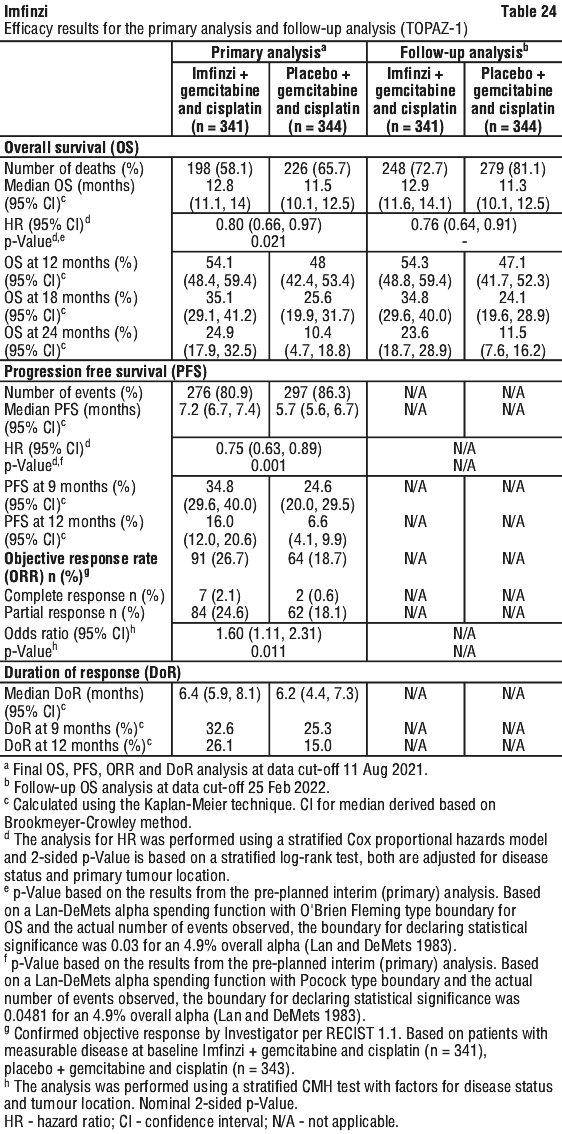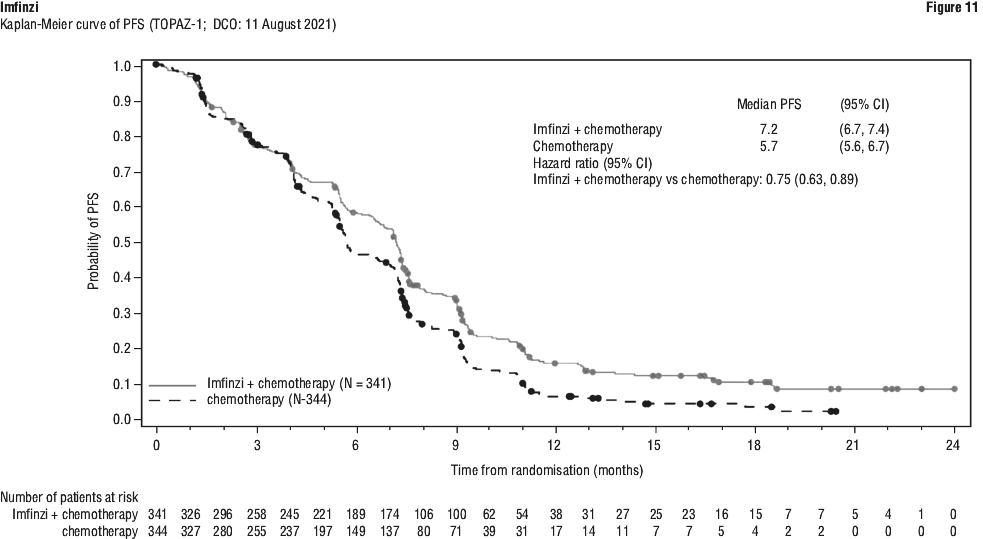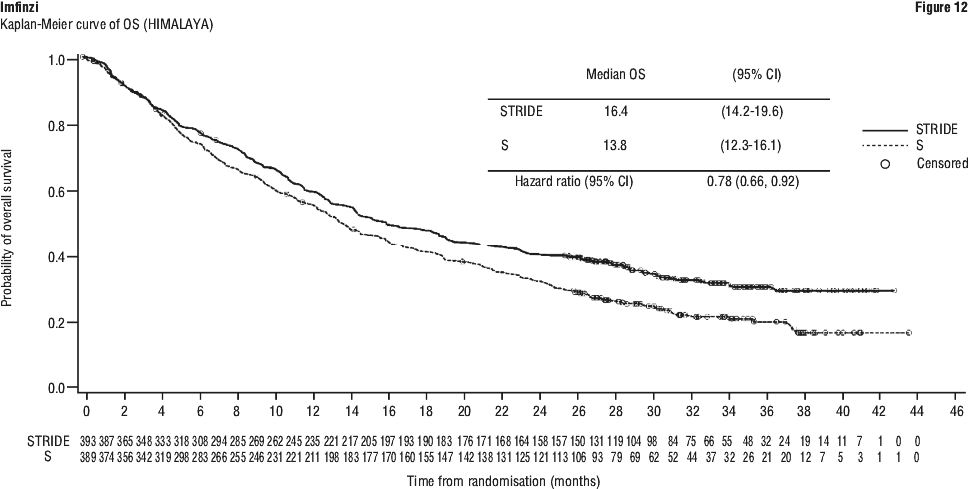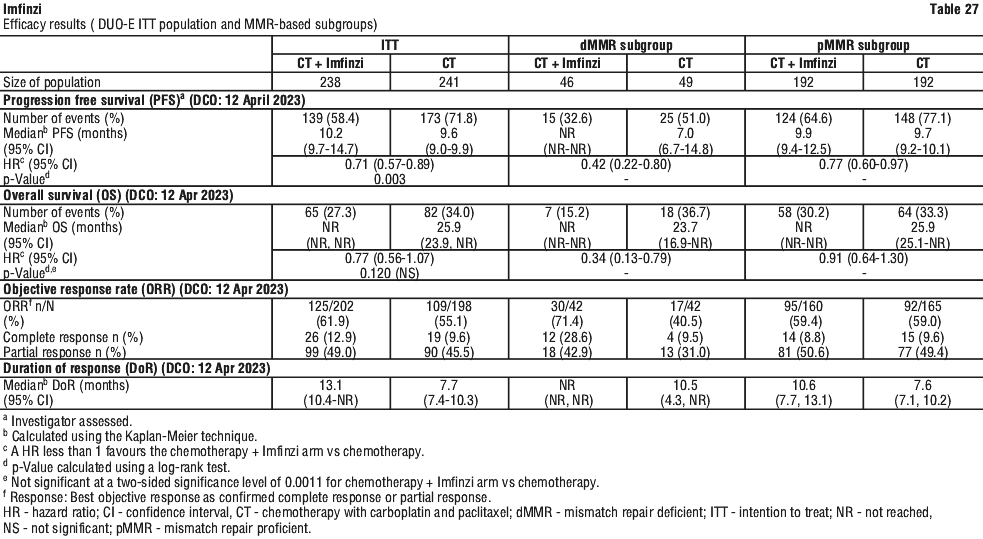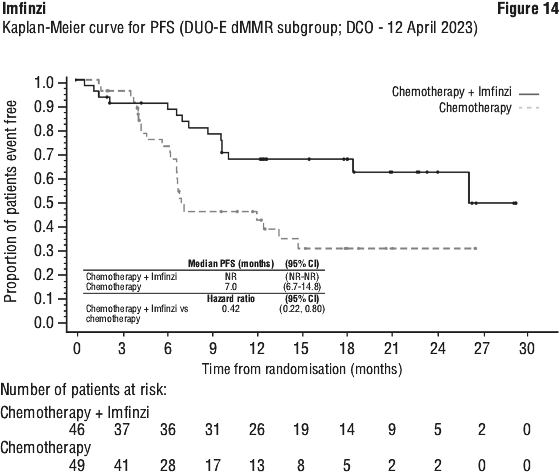SUMMARY CMI
IMFINZI®
Consumer Medicine Information (CMI) summary
The full CMI on the next page has more details. If you are worried about using IMFINZI, speak to your doctor or pharmacist.
1. Why am I using IMFINZI?
IMFINZI contains the active ingredient durvalumab. IMFINZI is used to treat several kinds of cancers.
For more information, see Section 1. Why am I using IMFINZI? in the full CMI.
2. What should I know before I use IMFINZI?
Do not use if you have ever had an allergic reaction to IMFINZI or any of the ingredients listed at the end of the CMI.
Talk to your doctor if you have any other medical conditions, take any other medicines, or are pregnant or plan to become pregnant or are breastfeeding.
For more information, see Section 2. What should I know before I use IMFINZI? in the full CMI.
3. What if I am taking other medicines?
Some medicines may interfere with IMFINZI and affect how it works.
A list of these medicines is in Section 3. What if I am taking other medicines? in the full CMI.
4. How do I use IMFINZI?
- IMFINZI will be given to you as a liquid infusion into your vein and your doctor will decide how many treatments you need.
More instructions can be found in Section 4. How do I use IMFINZI? in the full CMI.
5. What should I know while using IMFINZI?
| Things you should do |
|
| Things you should not do |
|
| Driving or using machines |
|
For more information, see Section 5. What should I know while using IMFINZI? in the full CMI.
6. Are there any side effects?
Like all medicines, IMFINZI can cause side effects, although not everybody gets them. Your doctor will discuss these with you and will explain the risks and benefits of your treatment.
When you take IMFINZI, you can have some serious side effects.
For more information, including what to do if you have any side effects, see Section 6. Are there any side effects? in the full CMI.
FULL CMI
IMFINZI®
Active ingredient(s): durvalumab
Consumer Medicine Information (CMI)
This leaflet provides important information about using IMFINZI. You should also speak to your doctor or pharmacist if you would like further information or if you have any concerns or questions about using IMFINZI.
Where to find information in this leaflet:
1. Why am I using IMFINZI?
2. What should I know before I use IMFINZI?
3. What if I am taking other medicines?
4. How do I use IMFINZI?
5. What should I know while using IMFINZI?
6. Are there any side effects?
7. Product details
1. Why am I using IMFINZI?
IMFINZI contains the active ingredient durvalumab. IMFINZI is a monoclonal antibody, a type of protein. It is a type of immunotherapy and belongs to a group of medicines called immune checkpoint inhibitors. It works with your immune system to destroy cancer cells.
IMFINZI can be used to treat a type of lung cancer called non-small cell lung cancer (NSCLC). It may be prescribed to you:
- in combination with chemotherapy that contains platinum prior to surgery (neoadjuvant treatment) and alone after surgery (adjuvant treatment) if:
- your cancer has spread within your lung and is able to be removed by surgery - alone if:
- your cancer has spread within your lung and cannot be removed by surgery, and
- you have tried radiotherapy and chemotherapy that contains platinum, and your cancer has shrunk or has not worsened.
IMFINZI can be used to treat a type of lung cancer called small cell lung cancer (SCLC). It may be prescribed to you:
- alone if:
- you have limited stage SCLC (LS-SCLC) and
- your cancer has not been removed by surgery and
- your cancer has responded or stabilised after initial treatment with radiotherapy and chemotherapy that contains platinum. - in combination with chemotherapy if:
- you have extensive stage SCLC (ES-SCLC) where your cancer has spread within your lungs (or to other parts of the body) and
- you have not received previous treatment.
IMFINZI in combination with chemotherapy can be used to treat a type of cancer called biliary tract cancer (BTC), such as cancer of the bile ducts (cholangiocarcinoma) and gallbladder. It may be prescribed to you if:
- your cancer has spread within these regions (or to other parts of the body).
IMFINZI in combination with tremelimumab can be used to treat a type of liver cancer, called unresectable hepatocellular carcinoma (uHCC). It may be prescribed to you if your cancer:
- cannot be removed by surgery (unresectable), and;
- has spread within your liver (or to other parts of the body)
IMFINZI can be used to treat a type of cancer of the lining of the uterus (endometrial cancer) that has spread beyond the original tumour or come back (recurred). It may be prescribed to you in combination with chemotherapy, followed by IMFINZI alone.
A test may be used to find out the mismatch repair (MMR) status of your endometrial cancer to help your doctor decide which treatment option may be the best for your cancer.
When IMFINZI is given in combination, it is important that you also read the Consumer Medicine Information (CMI) for the specific anti-cancer medicines you may be receiving. If you have any questions about these medicines, ask your doctor.
Your doctor may have prescribed IMFINZI for another reason.
2. What should I know before I use IMFINZI?
Warnings
Do not use IMFINZI if:
- you are allergic to durvalumab, or any of the ingredients listed at the end of this leaflet.
- Always check the ingredients to make sure you can use IMFINZI.
Some of the symptoms of an allergic reaction may include:
- shortness of breath
- wheezing or difficulty breathing
- swelling of the face, lips, tongue or other parts of the body
- rash, itching or hives on the skin.
Check with your doctor if you:
- have any other medical conditions (including immune system problems such as Crohn's disease, ulcerative colitis, or lupus; have had an organ transplant; have lung or breathing problems or have liver problems)
- take any medicines for any other condition.
During treatment, you may be at risk of developing certain side effects. It is important you understand these risks and how to monitor for them. See additional information under Section 6. Are there any side effects?
Pregnancy and breastfeeding
Check with your doctor if you are pregnant or intend to become pregnant.
You should not be given IMFINZI if you are pregnant.
It may affect your developing baby if you use it during pregnancy.
If you could become pregnant, you must use adequate birth control while you are being treated with IMFINZI and for at least 3 months after your last dose.
Talk to your doctor if you are breastfeeding or intend to breastfeed.
You should not be given IMFINZI if you are breast-feeding.
It is not known if the active ingredient in IMFINZI passes into breast milk, but if it does, there is a possibility that your baby may be affected.
Do not breast-feed if you are being given IMFINZI and for at least 3 months after the last dose.
3. What if I am taking other medicines?
Tell your doctor or pharmacist if you are taking any other medicines, including any medicines, vitamins or supplements that you buy without a prescription from your pharmacy, supermarket or health food shop.
Check with your doctor or pharmacist if you are not sure about what medicines, vitamins or supplements you are taking and if these affect IMFINZI.
4. How do I use IMFINZI?
How much and when to take IMFINZI
- IMFINZI will be given to you as a liquid infusion into your vein (IV). An infusion takes about 1 hour and will normally be given every 2, 3 or 4 weeks. Depending on your type of cancer, IMFINZI may be given in combination with other anti-cancer medicines.
- Your doctor will decide how many treatments you need.
When IMFINZI is given on the same day as chemotherapy, the IMFINZI infusion goes first, followed by chemotherapy.
When IMFINZI is given on the same day as tremelimumab, the tremelimumab infusion goes first, followed by IMFINZI.
Please refer to the CMI of the other anti-cancer medicines in order to understand the use of these other medicines. If you have questions about these medicines, ask your doctor.
If you miss an appointment to be given IMFINZI
Call your doctor right away to reschedule your appointment. It is very important that you do not miss a dose of IMFINZI.
5. What should I know while using IMFINZI?
Things you should do
Keep all of your doctor's appointments so that your progress can be checked.
Remind any doctor, dentist or pharmacist you visit that you are using IMFINZI.
Driving or using machines
Be careful before you drive or use any machines or tools until you know how IMFINZI affects you.
IMFINZI is not expected to affect your ability to drive a car or operate machinery.
Looking after your medicine
- Store unopened vials under refrigeration at 2°C to 8°C in the original carton to protect from light.
- Do not freeze.
- Do not shake.
Follow the instructions in the carton on how to take care of your medicine properly.
Keep it where young children cannot reach it.
Getting rid of any unwanted medicine
If you no longer need to use IMFINZI or it is out of date, take it to any pharmacy for safe disposal.
Do not use IMFINZI after the expiry date.
6. Are there any side effects?
All medicines can have side effects. If you do experience any side effects, most of them are minor and temporary. However, some side effects may need medical attention.
IMFINZI can cause your immune system to attack normal organs and tissues in many areas of your body and can affect the way they work and this can cause the side effects.
See the information below and, if you need to, ask your doctor or pharmacist if you have any further questions about side effects.
Serious side effects
| Serious side effects (signs and symptoms) | What to do |
Problems with your lungs:
| Call your doctor straight away or go straight to the Emergency Department at your nearest hospital if you notice any of these serious side effects. Your doctor may give you other medicines in order to prevent more severe complications and reduce your symptoms. Your doctor may withhold the next dose of IMFINZI or stop your treatment with IMFINZI. |
Problems with your eyes:
| Contact a medical eye specialist (ophthalmologist) straight away, or go straight to the Emergency Department at your nearest hospital if you notice these side effects as you may need urgent medical attention. |
Most common side effects reported in clinical trials:
| Most common side effects | What do to |
Reported in clinical trials with patients receiving IMFINZI alone:
| Speak to your doctor if you have any of these side effects and they worry you. |
Reported in a clinical trial with patients receiving IMFINZI in combination with chemotherapy followed by IMFINZI alone:
| Speak to your doctor if you have any of these side effects and they worry you. |
Reported in a clinical trial with patients receiving IMFINZI with etoposide and carboplatin or cisplatin:
| Speak to your doctor if you have any of these side effects and they worry you. |
Reported in clinical trials with patients receiving IMFINZI with gemcitabine and cisplatin:
| Speak to your doctor if you have any of these side effects and they worry you. |
Reported in clinical trials with patients receiving IMFINZI in combination with tremelimumab:
| Speak to your doctor if you have any of these side effects and they worry you. |
Reported in a clinical trial with patients receiving IMFINZI in combination with carboplatin and paclitaxel, followed by IMFINZI alone:
| Speak to your doctor if you have any of these side effects and they worry you. |
Some side effects can only be found when your doctor does blood tests from time to time to check your progress (eg abnormal thyroid gland function test (underactive or overactive), too much calcium in your blood, not enough sodium in your blood, not enough white blood cells, not enough red blood cells, not enough blood platelets, abnormal liver function tests (eg aspartate aminotransferase (AST) increased; alanine aminotransferase (ALT) increased) or pancreas function tests).
Tell your doctor or pharmacist if you notice anything else that may be making you feel unwell. Other less common side effects not listed here may occur in some people.
Reporting side effects
After you have received medical advice for any side effects you experience, you can report side effects to the Therapeutic Goods Administration online at www.tga.gov.au/reporting-problems. By reporting side effects, you can help provide more information on the safety of IMFINZI.
Always make sure you speak to your doctor or pharmacist before you decide to stop taking any of your medicines.
7. Product details
IMFINZI is only available with a doctor's prescription.
What IMFINZI contains
| Active ingredient (main ingredient) | durvalumab |
| Other ingredients (inactive ingredients) | histidine histidine hydrochloride monohydrate trehalose dihydrate polysorbate 80 water for injections |
Do not take IMFINZI if you are allergic to any of these ingredients.
What IMFINZI looks like
IMFINZI concentrated solution for infusion is a clear to opalescent, colourless to slightly yellow liquid in a glass vial.
Australian Registration Number(s):
IMFINZI, 500 mg (500 mg/10mL) in 10 mL vial for intravenous infusion - AUST R 283216
IMFINZI, 120 mg (120 mg/2.4mL) in 10 mL vial for intravenous infusion - AUST R 283215
Who distributes IMFINZI
AstraZeneca Pty Ltd
ABN 54 009 682 311
66 Talavera Road
MACQUARIE PARK NSW 2113
Telephone: 1800 805 342
This leaflet was prepared 17 April 2025.
IMFINZI is a trade mark of the AstraZeneca group of companies.
© AstraZeneca 2025
VV-RIM-01430609 v22
Published by MIMS June 2025

 It is recommended to continue treatment for clinically stable patients with initial evidence of disease progression until disease progression is confirmed.
It is recommended to continue treatment for clinically stable patients with initial evidence of disease progression until disease progression is confirmed. After withhold, Imfinzi can be resumed within 12 weeks if the ADR improved to ≤ Grade 1 and the corticosteroid dose has been reduced to ≤ 10 mg prednisone or equivalent per day. Imfinzi should be permanently discontinued for recurrent Grade 3 ADR, as applicable.
After withhold, Imfinzi can be resumed within 12 weeks if the ADR improved to ≤ Grade 1 and the corticosteroid dose has been reduced to ≤ 10 mg prednisone or equivalent per day. Imfinzi should be permanently discontinued for recurrent Grade 3 ADR, as applicable.
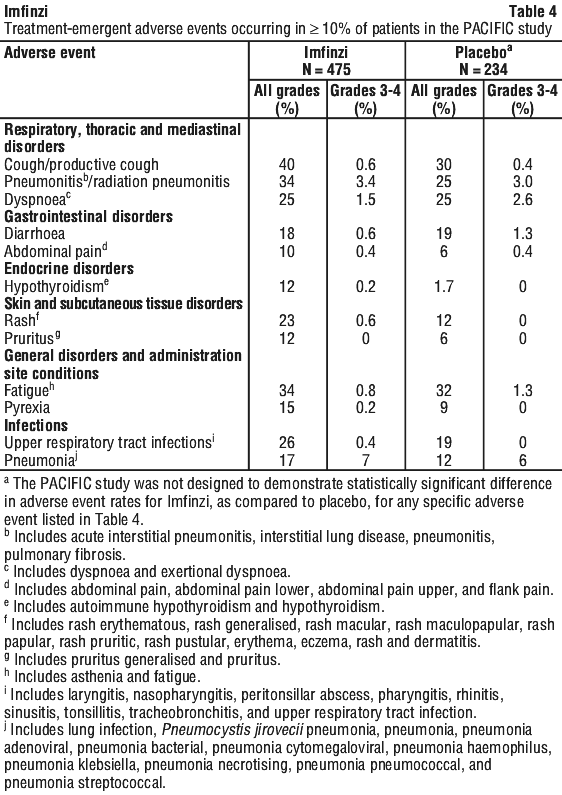 Other adverse events occurring in less than 10% of patients treated with Imfinzi were dysphonia, dysuria, night sweats, peripheral oedema, and increased susceptibility to infections.
Other adverse events occurring in less than 10% of patients treated with Imfinzi were dysphonia, dysuria, night sweats, peripheral oedema, and increased susceptibility to infections.



 Table 10 summarises the laboratory abnormalities that occurred in at least 20% of patients treated with Imfinzi plus chemotherapy.
Table 10 summarises the laboratory abnormalities that occurred in at least 20% of patients treated with Imfinzi plus chemotherapy. The proportion of patients who experienced a TSH shift from baseline that was ≤ ULN to any grade > ULN was 17.7% and a TSH shift from baseline that was ≥ LLN to any grade < LLN was 31.3%.
The proportion of patients who experienced a TSH shift from baseline that was ≤ ULN to any grade > ULN was 17.7% and a TSH shift from baseline that was ≥ LLN to any grade < LLN was 31.3%. Table 12 summarises the laboratory abnormalities that occurred in at least 20% of patients treated with Imfinzi plus chemotherapy.
Table 12 summarises the laboratory abnormalities that occurred in at least 20% of patients treated with Imfinzi plus chemotherapy.
 Table 14 summarises the laboratory abnormalities that occurred patients treated with STRIDE in the HIMALAYA study.
Table 14 summarises the laboratory abnormalities that occurred patients treated with STRIDE in the HIMALAYA study. Table 15 summarises the adverse events that occurred in patients treated with STRIDE in Study 22.
Table 15 summarises the adverse events that occurred in patients treated with STRIDE in Study 22. Table 16 summarises the laboratory abnormalities that occurred patients treated with STRIDE in Study 22.
Table 16 summarises the laboratory abnormalities that occurred patients treated with STRIDE in Study 22.


 The study demonstrated a statistically significant and clinically meaningful improvement in EFS of the Imfinzi arm compared to the placebo arm. The study also demonstrated a statistically significant and meaningful improvement in pCR of the Imfinzi arm compared to the placebo arm. OS data were not mature at the time of EFS analysis. See Table 20 and Figure 1.
The study demonstrated a statistically significant and clinically meaningful improvement in EFS of the Imfinzi arm compared to the placebo arm. The study also demonstrated a statistically significant and meaningful improvement in pCR of the Imfinzi arm compared to the placebo arm. OS data were not mature at the time of EFS analysis. See Table 20 and Figure 1.



 The improvements in PFS and OS in favour of patients receiving Imfinzi compared to those receiving placebo were consistently observed in all predefined subgroups analysed, including ethnicity, age, gender, smoking history, EGFR mutation status and histology. ALK mutation status was not analysed in this study.
The improvements in PFS and OS in favour of patients receiving Imfinzi compared to those receiving placebo were consistently observed in all predefined subgroups analysed, including ethnicity, age, gender, smoking history, EGFR mutation status and histology. ALK mutation status was not analysed in this study.

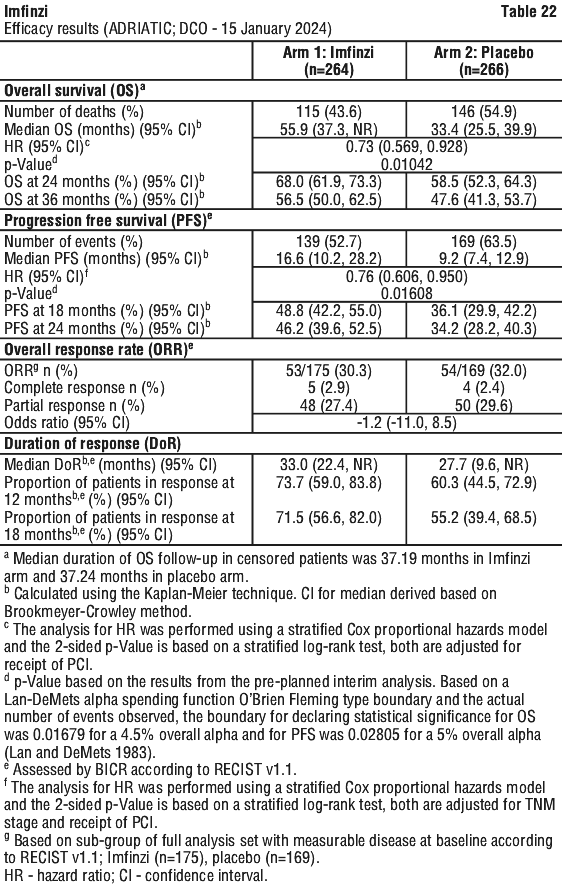

 The improvements in OS and PFS in favour of patients receiving Imfinzi compared to those receiving placebo were generally consistent across predefined subgroups analysed.
The improvements in OS and PFS in favour of patients receiving Imfinzi compared to those receiving placebo were generally consistent across predefined subgroups analysed.


